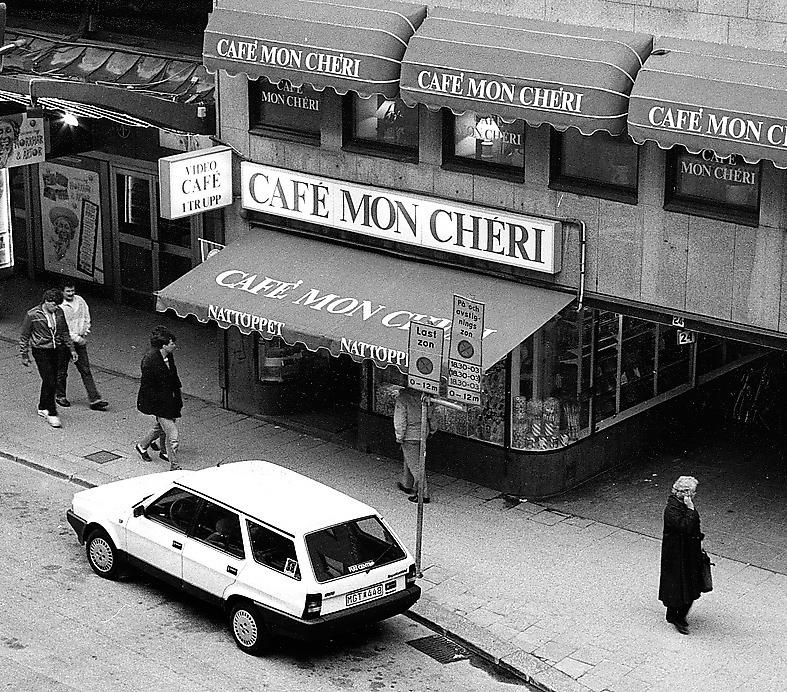Chapter 3 - Hans Holmér
Hans Holmér Takes the Lead
Hans Holmér is going to participate in the Vasaloppet.
At noon on Friday, Hans Holmér leaves his office at the police headquarters to participate in the Vasaloppet – a 90-kilometer (approximately 56-mile) classic cross-country ski race for elite and amateur skiers – which is always held on the first Sunday in March. This is going to be the eighth time in a row that Hans has participated in the race.
Hans and his new partner, Åsa, drive to Borlänge halfway to Sälen where the start is located, and spend the night at the Scandic hotel.
Early next morning, before breakfast is served at the hotel, Hans goes to the check-in desk to ask to fill a thermos with hot water. The girl at the desk asks him if he has heard about the murder. "No," he replies, "Here in Borlänge?" "No, in Stockholm. Palme has been shot," the girl continues.
Hans calls SBC, and Gilbert N, who has relieved Hans K as the duty officer, answers. Gilbert describes the situation in Stockholm. Gilbert says, "Gösta says you can go ahead and ski the Vasaloppet," referring to Deputy County Police Chief Gösta Welander. "I'll be there in a couple of hours," Hans replies.
Hans Holmér Arrives at SBC
During the night of the murder, Deputy County Police Chief Gösta Welander was leader for the Stockholm police. When County Chief of Police Hans Holmér arrived approximately 10:50 a.m. on the morning of March 1, he took over leadership.
Hans Holmér believed that since the murder had occurred in Stockholm, the investigation should be led by the Stockholm police. He therefore appointed himself as chief of investigation.
The national murder commission was on assignment elsewhere and sat in their hotel rooms waiting for the phone to ring; it never did.
At 12:00 p.m., Hans Holmér held his first of many press conferences.
The Palme-Group is Formed
This group comprised several leading personnel representing the departments that would be involved in the murder investigation.
- From the Stockholm Police Authority:
- Hans Wranghult, Chief Superintendent and Head of the Criminal Department
- Lennart Pettersson, Police Superintendent and Head of the Investigation Section
- Nils Linder, Commissioner and Head of the Violent Crimes Unit
- Vincent Lange, Commissioner and Head of the Forensic Department
- From the National Police Board:
- Tommy Lindström, Chief Superintendent and Head of the National Criminal Police
- Per-Göran Näss, a Bureau Chief from the Security Police (Säpo)
The group also included a representative ('observer') from the Ministry of Justice, Legal Counsel Klas Bergenstrand.
The Palme Group meets twice a day to discuss the progress of the investigation and coordinate efforts. A fragmented protocol is kept, and the meetings were taped, but only small portions of these recordings have been released, just enough to confirm their existence.
A second Bullet is Found
the Reword
On March 4, Hans Holmér announced a reward of 500,000 kronor for information that could lead to the arrest of a perpetrator.
The reward was later increased through a decision by the Swedich government on November 12, 1987. This decision meant that the government granted permission for the National Police Board to allocate a total of up to 50 million kronor as a reward to anyone who could provide information to the police leading to the resolution of Olof Palme's murder. Before the National Police Board made a decision to pay out a reward, the board was required to notify the government of its intention to do so.
An advertisement regarding the increased reward was published, among other places, in the newspaper International Herald Tribune on November 19, 1987.
The Weapon and the Bullets
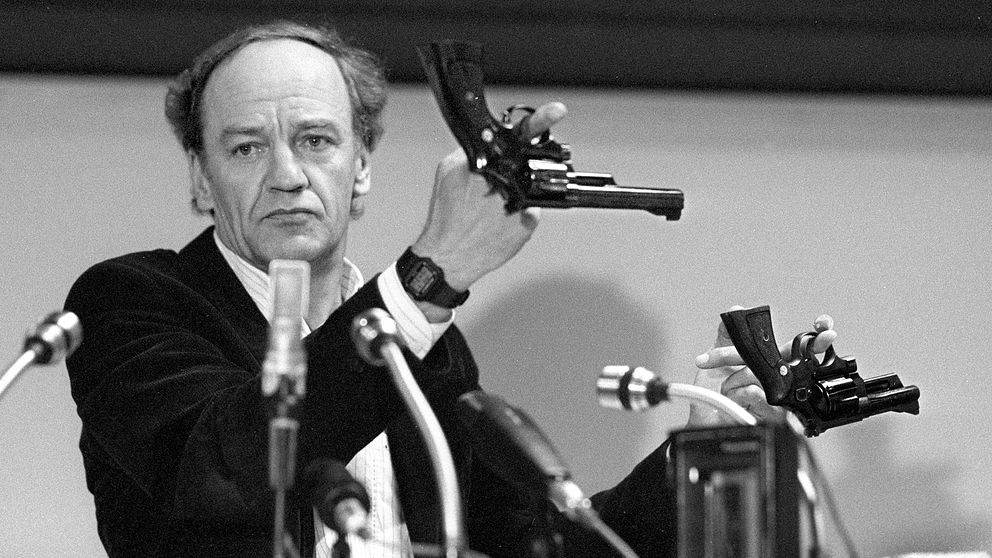
County Police Chief Hans Holmér holds up two Smith & Wesson "357 Magnum revolvers during a press conference at the police headquarters in Stockholm on March 31, 1986. This type of weapon is believed to be the type of weapon that may have been used in the assassination of Swedish Prime Minister Olof Palme" SVT.
Foto: Lars Hedberg/TT
Här är vapnen som utretts kring Palmemordet/SVT
The Sucksdorff Revolver
A revolver was stolen from the home of filmmaker Arne Sucksdorff in Stockholm in 1977. The thief, whose identity is known, claims that he later sold the revolver, a Smith & Wesson Highway Patrolman with a six-inch barrel, for 2,000 kronor. It is known that it has a wooden grip with a filed groove in it..
The Mockfjärd Revolver
On September 6, 1983. A Smith & Wesson .357 Magnum and 91 rounds of Winchester metal piercing caliber .357 were stolen during a house burglary in Haparanda . The burglary was solved and the perpetrator who took care of the weapon was Veijo R.
On September 28, 1983, the Savings Bank in Bruzaholm was robbed. The crime was solved and Veijo R, Lasse A and Jorma K were convicted of it. The robbery took place so that Veijo R and Lasse A were masked and armed with an axe and the revolver that had been seized in Haparanda, respectively. Jorma K, who drove the getaway car, waited in it outside the premises. When the robbery was carried out, the getaway car was driven to a gravel pit where they changed cars.
On October 27, 1983, the post office in Mockfjärd was robbed. Two masked robbers entered the post office at 10.25 in the morning. The men were armed with an axe and a revolver. A third man was still sitting outside in the getaway car, a grey Volvo PV model year 1966.
One customer, the then 61-year-old Grabb Gunnar Olsson, was inside the post office and was shot in the robbery. He thought the robbers were little boys who were just joking. He grabbed the revolver barrel and pulled it downwards. A shot went off and hit the man in the thigh. His right femur was shattered and he never fully recovered from the gunshot wound.
It was payday at the Elementhus house factory and therefore there were unusually large sums of money at the post office. The robbers came across a total of 167,000 kronor.
The getaway car was found a few hours later, abandoned on a forest road near Lillstup, south of Mockfjärd.
The case was never solved, but the police are convinced that it is the same perpetrators behind all three crimes and that the stolen revolvers were used in the two robberies. The robbery in Mockfjärd became time-barred on October 27, 1998.
On March 11, 1986. a detective inspector who worked at the National Criminal Investigation Service announced that he had previously participated in a robbery investigation, in which a Smith & Wesson .357 Magnum revolver had been involved. The revolver had never been recovered. According to information from a Veijo R, a person named Lasse A took the revolver to a brother in Norway at the end of September 1983. During the investigation, Lasse A had been arrested in Finland and extradited to Sweden in April 1984. He had then denied any knowledge of the weapon. In one of the robberies, which had taken place against a post office in Mockfjärd, a bullet had been fired and recovered. This bullet, which will continue to be called "Mockfjärdskulan", would be at the National Forensic Science Laboratory (SKL).
The Composite sketches
On March 4, the Palme Group contacted the BKA in Wiesbaden to request a machine capable of creating composite sketches. The following evening, German police from the BKA arrived with the composite sketch machine in Stockholm and the equipment was set up in a hotel room at Hotel Amaranten.
Twenty-two witnesses who had provided descriptions of individuals potentially involved in the murder of Olof Palme were chosen to participate in the creation of the composite sketches. The observations were made between Christmas 1985 and February 28, 1986.
The Ghost Image
On March 6, at 8:00 a.m., the first image was made public. It claimed to resemble a possible perpetrator. This image became widely known as 'The Ghost Image,' and it is this image we refer to when mentioning 'The Ghost Image.'
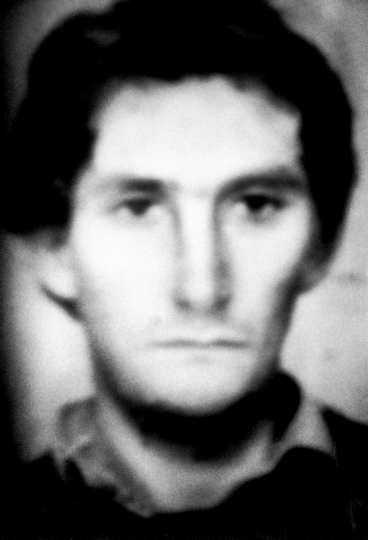
Composite Sketch of the Suspect 'The Ghost Image'.
The police
The observation upon which the image was based had been made by a woman, Susanne T, on February 28, 1986, between 11:30 p.m. and 11:40 p.m. At this time, Susanne T had briefly left the Alexandra restaurant, where she was, and exited onto Smala Gränd via the staff entrance. As she opened the gate towards Smala Gränd, she had almost bumped into a man who was walking hunched over, with his hands in his trouser pockets. When the man saw her, he had looked startled and turned away. He then quickened his pace, and at Snickarbacken, he had turned right towards Birger Jarlsgatan. Susanne T had provided a detailed description of the man and had also made her own drawing of him.
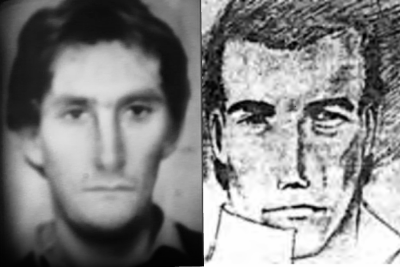
The Ghost image kompered with Susanne's sketch
The police
Why the police specifically chose this image remains somewhat of a mystery. The observation made by Susanne T occurred 1,350 feet (400 meters) from the crime scene and had no direct connection to the crime. The simple explanation is that it was the best description available, but some evil tongues suggest it was selected because it was the image that most resembled a Kurd.
EAE:522
The Shadow Image
On March 24, at 10:00 a.m., a second composite sketch was released, known as 'The Shadow Image'
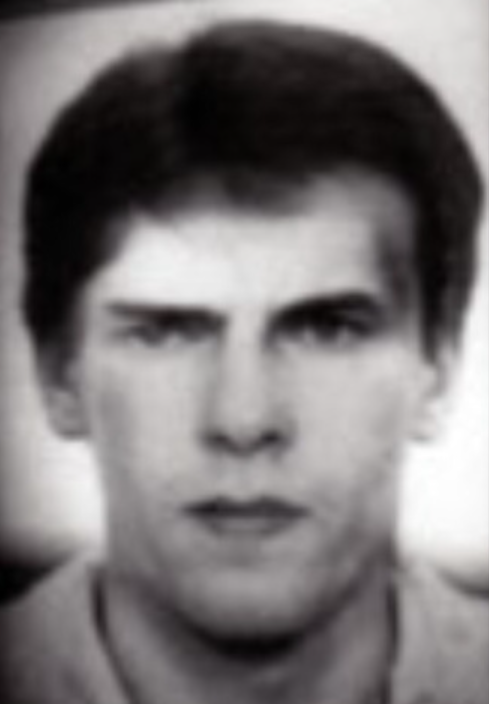
Composite Sketch of the Suspect 'The Shadow Image'.
The police
The observation upon which the image was based had been made by a man, Patricio M, on Thursday, February 27, when Olof Palme was out shopping for a suit. Patricio saw a man who seemed to be following Palme as Palme was crossing Sergels Torg.
D:1336
Unpublished Composite Sketches
Mårten Palme
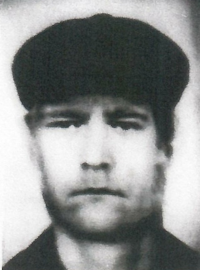
Mårten Palme makes a composite sketche of the man he sees loking in to a shop window when he left his parents outside the cinema.
T:2
Witness Per M
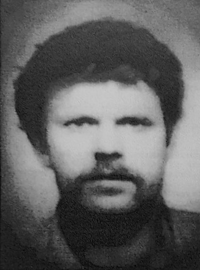
Per makes a composite sketche of a man he sees coming down the stairs to 📍Old Town metro station just after the Palme couple had passed.
Z:8124
Witness Leila K
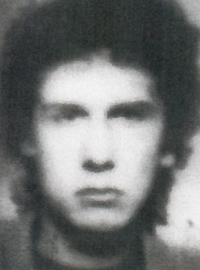
Leila is traveling with the metro, and upon arriving at Gamla stan, she sees the Palme couple entering the train through the back doors to her carriage. Just as they are about to leave the station, a man forces himself through the middle doors to the carriage. Leila makes a composite sketch of the man.
Z:8332
The Numerous Walkie-Talkie Observations
Witness Ulla S
Ulla provides her information to the police on March 5, 1986, at which point an investigation lead is registered. On March 6, 1986, she is interviewed by telephone.
Ulla works at the newspaper Svenska Dagbladet, where she is involved in sales, until around 8 p.m. in the evening when Olof Palme is murdered. She takes the subway from Fridhemsplan towards the Old Town at 8:22 p.m. The train arrives at the Old Town Metro Station between 8:32 and 8:34 p.m. On the platform for the southbound train, she sees a man who has plugs in his ears and a shiny metal rod sticking out of his coat collar. She passes the man, and when she gets 16–20 feet (5–6 meters) away from him, she hears a noise. When she then turns around, she sees him, facing the platform for the northbound train, talking into a shiny metal walkie-talkie or something similar that he is holding in his left hand. The man is wearing gloves. She then goes down the stairs and exits through the barrier. She is heading to Hotel Gamla Stan, where she works extra and has her salary to collect. She walks along Schönfeldtsgränd. There, she observes another man who comes and stands in a doorway niche of a shop that overlooks the entrance to the Old Town metro station and is occupied with some kind of phone. She hears the man saying something, but not what.
On March 11, 1986, at 3:30 p.m., Detective Inspectors Bengt F and Torbjörn S meet with Ulla S outside the Gamla Stan subway station, so that she can precisely describe the route she took from the subway to Hotel Gamla Stan. During the walk with the police officers, she describes the route she took and explains in detail how and where the men had stood and how they had behaved, which does not differ in essence from what she had previously stated.
She further explains that she took bus 56 from work with a colleague to Fridhemsplan on the evening in question.
Ulla also states that she contacted Torbjörn S, a police officer at Nacka Police, whom she knew, and that it was he who contacted the Palme Group.
In the interrogation protocol, the following noteworthy comment is made: "Comment: We find it very difficult to determine the truthfulness of what Ulla S has recounted."
(It later emerges that the police internally referred to Ulla as "Bag Lady," which is a strange epithet for a woman working two jobs.)
On March 12, 1986, at 11:15 a.m., the Palme Group contacts Torbjörn S at Nacka Police. He states that he has known Ulla S for many years. He states that she has had some psychological problems but does not believe that she would deliberately invent such a story. He is convinced that she has recounted what she feels she experienced. That is also why he has forwarded her message.
Z:8075
Anonymous Letter Writer
The first handwritten letter stamped March 5, 1986, in Skelleftehamn and addressed to Hans Holmér is delivered to the Palme group. The transcript reads
Hello
I was in Stockholm on a temporary visit when Olof Palme was murdered. I was walking on Olofsgatan and crossed Tunnelgatan on my way to Centralen (Central Station), where I was supposed to meet a friend. I was severely delayed and in quite a hurry, which is why I constantly checked my wristwatch, and for that reason, I know that my time indication is absolutely correct. At the intersection of Olofsgatan and Tunnelgatan, a man was standing and speaking into a walkie-talkie. And he wasn't speaking Swedish. It sounded like German, but I myself am inclined to believe it was Dutch or possibly Swiss German. The time was exactly 23 minutes past 11:00 p.m. (23:23). I thought it seemed strange but assumed it was some kind of guard. I saw the man's face and clothing very clearly because I looked twice. He had straight dark blond hair, combed to the side, no glasses, and in my opinion, looked very "Swedish." He had very dark stubble, as if he hadn't shaved that day. He was wearing a dark blue, mid-length parka jacket with a fur collar on the hood, dark, probably corduroy trousers (blue). I also managed to see that he was wearing black gloves (leather, so-called finger gloves). He was about 185 cm tall; I am 179 cm myself, but he was slightly taller than me (he was large). As I passed the intersection, I turned around again, and he was still standing there. He seemed to be in a hurry, or rather – "the conversation seemed agitated."When I passed the intersection, I didn't notice anything unusual on Sveavägen.
Please note that I am not telling you this to receive any reward, but when I read Expressen's article yesterday, "3 men formed a ring around Palme," I thought there might be a connection here.
I assure you, on my honor and conscience, that my observation and my time indication are absolutely correct.I live in Skelleftehamn outside Skellefteå. For the time being, I wish to remain anonymous.
On March 8, 1986, Hans Holmér goes public in the media and asks the anonymous letter writer to get in touch. In the days that followed, more information about the case is gradually released to the media.
The second handwritten letter stamped March 11, 1986, in Linköping and addressed to Hans Holmér is delivered to the Palme group. The transcript reads
I am the anonymous letter writer.
For days, I have dedicated myself to drawing a portrait of the man I saw on Olofsgatan in connection with the murder of Olof Palme. I believe I have succeeded very well, apart from the somewhat blunt/protruding forehead which was slightly prominent just above the eyebrows. I cannot depict that from a frontal view. Note the strong jawline, the down-drawn mouth reminiscent of a hare-lip, the very strong neck, the bent nose – but not a hooked nose – which was coarse, as well as the distance between the eyes. The entire man was strong, large, and sturdy. Height 183-185 cm. Dark eyes. As I previously mentioned, he was wearing a dark blue parka, mid-length with a grey-white fur collar. One professional category uses them – postal staff or perhaps ST-personnel.
In my first letter to you, I did not mention everything. I 'saved' some. I claimed that the man was speaking German, and I still maintain that. When I was level with the man, he said the following. ... Das Auto, das Auto ... incomprehensible ... (word) Feuf, they say in Switzerland instead of Fünf.He said Auto with a long - å - and emphasis on the first syllable, like this: ... Aut å å å He was talking agitatedly. He held the walkie-talkie with both hands. He was wearing black leather finger gloves. Dark eyes. The device crackled and rattled, and the receiving party's reply came jerkily and intermittently; I managed to catch that. A lot of interference and static, as if many were on the line simultaneously. I know the man had dark trousers and shoes, probably those common black ones – moccasin style.
I have pondered and pondered what I heard. To me, it is becoming increasingly clear that the man might have been directing a car, or calling for a car. The man never heard me coming. He startled and looked at me just as I walked past him. And I looked at him, perhaps that's why I drew the man with his gaze directed downwards. That's how he looked at me, namely.
I am a traveling saleswoman in the women's fashion industry. I have, so to speak, inappropriate relationships everywhere. But, I am terrified to come forward! Afraid of reprisals. Please respect that I wish to remain anonymous.
There was truly hysteria surrounding my first, anonymous letter, and that scared me even more. Do not contact mass media; just inform them that the witness has made contact, and then perhaps I will come forward. One might wonder why I walked on Olofsgatan. Whenever I am in Stockholm, I always take backstreets to avoid being accosted by various 'drunkards', beggars, intoxicated youths, etc. I came from an acquaintance on Tegnérgatan, walked Sveavägen for a bit, then turned onto Adolf Fredriks kyrkogata and then onto Olofsgatan, across Kungsgatan, diagonally across Hötorget, Gamla Brogatan down to Drottninggatan, past Postgirot, over Klarabergsviadukten and down into T-centralen (Central Station). I cannot think of anything else that might be of value to the police. Finally, I did not see a single person on Olofsgatan before I encountered this man.
It is not true that I live in Skelleftehamn, as I stated in my first letter. I live in a completely different direction. Check the postmark on this letter. I travel, so I can post the letter anywhere.
Good luck with your work. Hans Holmér is an admirable human being. If this involves an international "gang," tighten security extra carefully at Olof Palme's funeral. It is very possible that the murderer/s might try to leave the country then.
No, I had nothing to do with the murder. I have barely seen a firearm before and have never held one...
I will contact you by phone eventually. Be patient.
EBE:898
Walkie-Talkie Sightings Reported After the Public Appeal
Tips about walkie-talkies received after Hans Holmer's call to the public to report walkie-talkie sightings:
On March 14, 1986, Margarethe A reports a walkie-talkie sighting to the Palme Group. Margarethe A says that on the night of the murder, she is in her home on Tunnelgatan with her son. When she looks out the window around 8:00–9:00 p.m., she sees a man standing at a door on the corner of Olofsgatan/Tunnelgatan. The man speaks into a black walkie-talkie. In connection with the observation, she comments on this to her son. Shortly after ten o'clock, when her husband comes home, the man with the walkie-talkie is gone.
The next day, Margarethe A.'s son is interrogated. He confirms his mother's information. He himself observes the man on the other side of the street. The man holds a walkie-talkie in his hand, partly hidden inside his jacket. Part of the device sticks up, and the antenna is fully visible. The son thinks that the man is a security guard.
The tip-off is followed up by the Palme Group through a check with the personnel manager of the organization that is located in the building outside which the man was standing, and through a check with a security company. No actions that involve civilian personnel with walkie-talkies outside the building in question occur at the time of the observation.
In the autumn of 1988, Margarethe A and her son are questioned again without any further information being revealed.
EAA:1884
On March 24, 1986,Magnus Prim
EEE:2618
On March 26, 1986, Mare R submits a tip to the Palme group. On the morning of February 26, 1986, around 10:00 a.m., she intends to visit a shop in the Old Town. The store does not open until 10:30 a.m., and while waiting for it to open, she walks around the surroundings. She then observes a large man with a walkie-talkie on Västerlånggatan. She thinks the man is a shop assistant and describes him as a Central European – German, Austrian or similar – with blond "straw yellow" hair. The man makes a "uniform impression." A few days later, Mare R points out to the police the place where she had seen the man. She indicates a spot outside Västerlånggatan 28, located very close to the gate to the property where Olof Palme has his residence. At a follow-up interrogation in April 1986, Mare R states that she is absolutely sure that what she had seen the man carrying is a walkie-talkie. She had seen the antenna and part of the device.
Z:8641
April 7, 1986, Jarl N contacts the Palme group. He says that on February 26, 1986, he is on Västerlånggatan in the Old Town with his brother. Around 10:00–11:00 a.m., he notices a man talking into a walkie-talkie. The man looks "dangerous" and speaks German, probably as they do in Switzerland. He is 6'1" to 6'3" (185–190 cm) tall and has cendré-colored hair. Jarl is aware that it has taken him a long time to call the police, but he had forgotten about it. He is reminded of it when he hears, reads, or sees that another person has provided similar information.
A few days later, a new interrogation is held with Jarl. He then changes his information to some extent and says that he is not sure whether it is on February 26 or 27, 1986, that he and his brother visit the Old Town and that the observation is made around 11:00–11:30 a.m. The man he observes is about 100 feet (30 meters) into Västerlånggatan, seen from the north, on the east side of the street. The man has his face turned towards Olof Palme's home. About 50 meters further south, in an adjacent alley west of Västerlånggatan, stands another man, who holds something to his ear, probably a walkie-talkie. At the time of the sighting, Jarl N does not know that Olof Palme lives at Västerlånggatan 31.
Jarl N.'s brother is interviewed. He confirms that he walks on Västerlånggatan in the Old Town at the time stated by Jarl N. However, he has not observed any man with a walkie-talkie.
Z:8713
On March 30, 1987, Leif K contacts the Palme Group and talks about an observation he made on the night of the murder. He is in the Old Town in the company of four others on the night Olof Palme is murdered. The party intends to visit an entertainment venue located there, but since they think the entrance fee is too high, the group walks around the district instead. During the walk, when the party is not gathered but the men have probably gone a little ahead of the women, Leif K notices a man holding a walkie-talkie in his hand. The man is standing on a street corner. Leif K assumes that the man is a police officer. The observation takes place between 7:00 and 7:30 p.m. When asked why Leif K has not contacted the police earlier, he replies that he only realized a few weeks earlier that Olof Palme was living in the Old Town at that time.
At a follow-up interrogation in April 1987, Leif K specifies where he observed the man. The man was standing at the intersection of Västerlånggatan/Kåkbrinken, a few steps into the alley. Leif K describes the man as a Swedish, light-haired short-haired man, 20–30 years old and 5'11" (180 cm) tall. During the walk, Leif K comments on his observation and says something about "civilian police being everywhere."
When questioned by the other people in the party, the two men confirm that they have a memory of Leif K talking about a man with a walkie-talkie at the time. However, none of them saw the man. One of the women in the party states that at the time she observed a man with a walkie-talkie partially hidden under his coat. The man was standing on Västerlånggatan, not in any alley.
Z:9077
On April 6, 1987, Karin G contacts the Palme Group. She says that on the night of the murder, at about 9:20 p.m., she is driving south on Sveavägen. At the height of Adolf Fredrik's Church (the intersection of Sveavägen and Kammakargatan) she sees a man with a walkie-talkie. The man is 5'10" to 5'11" (178–180 cm) tall, has dark, "frizzy" hair, and is clean-shaven.
In October 1987, a follow-up interview is held with Karin G. She says that she is on her way home in a car with a friend, Bengt C. During the journey, she notices a man with a walkie-talkie who is standing along the cemetery wall outside Adolf Fredrik's Church. The man is talking into the device, and she has seen a "rod" sticking up a few decimeters. Her friend does not see the man. It is not until the spring of 1987 that she speaks to a friend who is a police officer about her observation. He recommends that she contact the Palme Investigation Unit (PU).
In September 1988, Karin G is questioned again. She then mentions that she had not believed that her observation had anything to do with the murder and that she therefore did not contact the police at first.
At the same time, in September 1988, Bengt C is interrogated. He says that Karin G mentioned her observation already during the car ride, but he did not have the opportunity to look at the man because of the driving.
EAC:6951
On March 3, 1992, Marianne Ö contacts the Palme Group. She says that she was in the Norra Latin schoolyard on the night of the murder, approximately between 10:30 and 11:00 p.m. There, she noticed a man who was about 65 feet (20 meters) away from her. The man was holding an object in front of his face that Marianne Ö "absolutely perceives as a walkie-talkie." Marianne Ö describes the man as Swedish, approximately 25–30 years old. As an explanation for only contacting the Palme Group after six years, Marianne Ö states that she was "cowardly" and did not want to "get involved."
EBC:14459
The "33-year-old".
In the section on Viktor Gunnarsson, I have not read all the police reports; this part is based on second-hand information mainly from "Report of the Inquiry Commission regarding the Criminal Investigation following the Murder of Prime Minister Olof Palme (SOU 1999:88)". I am still including it in the text and hope to do better at a later date.
Misstankar riktas mot 33-åringen.
Shortly after the murder, police began to receive tips about a man named Viktor Gunnarson.
- A young woman contacted the police with a tip already on the evening after the murder. She recounted that the previous evening she had been at Café Mon Chéri on Kungsgatan with two female friends. They had conversed with a man who expressed his hatred for Olof Palme. The man had handed over a business card with the name Vic G and a telephone number.
- An anonymous woman tipped off the police that Viktor, who had claimed to have fought for the USA against North Vietnam, had stated, 'Olof Palme is too conservative and is on the KGB's execution list. Blood will flow.'
- Another individual tipped that Viktor, a member of an extremist organization, had spoken about overthrowing Olof Palme.
- A woman and a man informed the police that an acquaintance of theirs, Victor, possessed a weapon of the type they had seen in the newspaper after the murder. They also stated that Viktor G. often frequented Västerlånggatan, disliked Olof Palme, had suddenly acquired 30,000 SEK for an apartment purchase, and had claimed to have been trained by the FBI and CIA.
In Swedish legal practice, the police run the investigation until a suspect is identified, at which point the prosecutor takes over. In this case, Chief Prosecutor K.G. Svensson took over the part of the investigation that involved Viktor Gunnarsson.
On March 6, K.G. Svensson assumed the role of lead investigator concerning Viktor G.
On March 8, K.G. Svensson decided that Viktor Gunnarsson should be brought in for questioning, and a search warrant was executed at his home at Klövervägen 6 in Norsborg, a suburb south-west of Stockholm.
Victor G. tells the investigators that he had been at a café, Mon Chéri, on the evening of February 28, where he had conversed with three girls. He believes he had then attended a late-night show at the Rigoletto cinema on Kungsgatan, and that he might have grabbed a burger at McDonald's before taking the subway back to Norsborg. However, he isn't certain.
After a briefing the same evening, Hans Holmér decided that Viktor G should be released. The seizure that had been made in connection with the search was lifted.
On the morning of March 12, Viktor G. was brought in for new questioning. Concurrently, a new search warrant was executed at his residence. Several articles of clothing, along with other materials, were seized and handed over to the Forensic Department for trace evidence analysis that could be linked to the shooting, and for the deciphering of indented writing on certain stationery. Anti-Palme material, such as EAP documents (also known as the LaRouche movement in Sweden) with underlined anti-Palme statements, was also found and seized.
In the afternoon, he was notified of suspicion of complicity in the murder of Olof Palme. He was arrested later that evening.
On the afternoon of March 14, the National Laboratory of Forensic Science (SKL) informally announced that two small primer residue particles had been found on the sleeve of Viktor G.'s parka. However, the particles originated, with 100 percent and 95 percent certainty respectively, not from the same type of ammunition as the recovered bullets. The seized clothes were transferred to the Bundeskriminalamt (BKA) in Wiesbaden for further examination.
On March 17, the BKA provided the preliminary feedback that it could not be ruled out that the primer residue particles on Viktor G.'s parka were from Winchester ammunition. On the same day, K.G. Svensson submitted a request for his remand in custody to the Stockholm District Court. The District Court decided that the remand hearing would take place on March 20, 1986.
The Witness on the Ridge
Investigator Börge W arranged a line-up on March 16, and Ibrahim D identified Viktor G as the man who had stopped him.
In connection with the preparations for the detention hearing, the prosecutors received a transcript of the line-up that Börge W had conducted with Ibrahim D on March 16. The prosecutors then became aware that the line-up had been preceded by a photo identification that included Viktor G. Ibrahim D had thus seen a photograph of Viktor G before the line-up; this prior exposure may have influenced his identification during the line-up. Furthermore, it emerged that the line-up had been conducted without an interpreter, despite Ibrahim D speaking limited Swedish.
K.G. Svensson therefore decided that a new interrogation with Ibrahim D should be conducted immediately. Svensson himself conducted the interrogation in the presence of an interpreter. At the end of the interrogation, a direct confrontation took place between Ibrahim D and Viktor G. Ibrahim D maintained that Viktor G was the man who had stopped him, but he stated that the man had worn a hood, hat, or similar, so that not much of his face had been visible. During the confrontation, Viktor G began speaking French with Ibrahim D.
Following the interrogation with Ibrahim D, K.G. Svensson decided that Viktor G. should be released. However, Viktor G. remained a suspect in the murder of Olof Palme, and on the same day, at K.G. Svensson's request, the District Court decided on wiretapping concerning Viktor G. The wiretapping then continued until April 30, 1986.
On May 16, K.G. Svensson decided to discontinue the preliminary investigation against Viktor G., stating that the investigation had not provided any support for the assumption that Viktor G. had been involved in the crimes, and that there was no longer any reason for the preliminary investigation to continue. Remaining seizures were lifted. With this decision, K.G. Svensson left the investigation.
Finally, regarding the prosecutor's role in the investigation concerning Viktor G., I wish to state the following. Viktor G. could have been dismissed from the murder investigation much earlier had the Palme group not disrupted and hindered a rational process on the prosecutor's part, through its involvement in the preliminary investigation management, actions in various directions, and attempts to pressure the prosecutor through various channels. In my opinion, Viktor G. has been subjected to a serious miscarriage of justice. It is not my place to make any further statements about the question of responsibility in this regard. I welcome the government's swift intervention concerning the establishment of an inquiry commission. In my opinion, it is necessary that a comprehensive and complete review and clarification of the entire legal affair concerning Viktor G. takes place as soon as possible.
K.G. Svensson
The investigation into Viktor Gunnarsson continues
PKK: The Kurdistan Workers’ Party
PKK Defectors Are Murdered in Uppsala
On June 20, 1984, Enver Ata, 26, a defector from the Kurdish left-wing party PKK, is shot dead while waiting for a bus on Stora Torget in Uppsala.
Enver Ata is shot from behind, from close range, with several shots. The murderer, Zülküf Kilinc, is arrested after a short escape, during which he throws the murder weapon. Kilinc states during the investigation of the crime that he acts on his own after "the Kurdish people sentenced Ata to death."
However, the investigation shows that Kilinc probably has several accomplices both in Sweden and abroad and that the murder is probably an execution ordered by the PKK leadership due to Ata defecting from the organization and publicly expressing criticism of the party.
This information comes from, among others, PKK defectors Cetin Güngör and Cemile K. They say that Ata, after his defection from the PKK, received death threats from the PKK leader Ali C and his aides. Güngör and Cemile K, who both call the PKK a terrorist organization, have also been subjected to threats.
Kilinc is sentenced in July 1984 for murder to life imprisonment.
Murder at Medborgarplatsen in Stockholm
On November 2, 1985, Cetin Güngör is murdered in the foyer outside the Stora Hörsalen (Main Auditorium) in Medborgarhuset in Stockholm. Güngör is participating in a Kurdish cultural celebration when he is shot in the back of the head, from close range. The perpetrator, Nuri Candemir, manages to throw himself through a window, out onto Götgatan, after further shooting. There, he is overpowered by party participants and is handed over to the police.
During questioning, Candemir states that he murdered Güngör on behalf of the Kurdish National Liberation Struggle Protection Association (a group with five members, of which Candemir was one), that he was provided with a photograph of Güngör in Kurdistan, that he arrived alone in Sweden from Germany via Denmark the day before the murder, and that he brought the murder weapon, a .22 caliber pistol, with him from abroad.
The investigation that is undertaken shows that Güngör was a prominent PKK member who defected from the organization when he came into conflict with its ideology and structure. He had publicly criticized the PKK in various publications and speeches. As a result of this, Güngör was sentenced to death by the PKK leadership, which announced the sentence in its own publications in February 1984. The death sentence is the reason why Güngör fled and settled in Sweden. In Sweden, Güngör continued to criticize the PKK.
The murder weapon is revealed to have been stolen during a burglary in Handen in 1978, along with, among other things, a Smith & Wesson .357 Magnum revolver. The weapon was handed over to Candemir by Halis I. At the time of the arrest, Candemir has keys on him that belong to Halis I.'s apartment, and there is information indicating that Halis I and Nezmi A (cf. below regarding the event on Christmas Eve 1985) pointed out the victim to Candemir.
It is established through surveillance that Candemir was observed on several occasions in Sweden during the autumn of 1984. During this time, he met with several leading PKK representatives, including Hussein Y and Remazan Y. During the summer of 1985, Candemir and Hussein Y had frequent contact with each other. In addition to being observed together on several occasions, they had relatively frequent contacts by phone.
In the telephone tapping material, there is a call that is presumed to concern the murder of Güngör. The call, which is one of the so-called "wedding calls," is made by a man, who is assumed to be PKK leader Ali C, on August 16, 1985, to Hussein Y. The man announces that the "wedding" will be held and that "pastries" will be sent to Hussein Y. The Swedish Security Service (Säkerhetspolisen) questions whether these words are code words and whether the call actually concerns the upcoming murder of Güngör (see the section below on the work of the so-called analysis group).
Candemir is sentenced to life in prison for murder in February 1986. He denies that the murder was a contract killing ordered by the PKK. Several people are suspected of involvement in the murder, but the suspicions never gain such strength that anyone is served with such suspicion at this time.
Later, during the major raid against Kurds on January 20, 1987 (Operation Alpha), several of these individuals are, however, questioned as suspects in the complicity of the murder of Güngör.
Assault at Slussen Subway Station on Christmas Eve 1985
On Christmas Eve 1985, Nezmi A is stabbed at Slussen subway station in Stockholm by Muhamed K. Nezmi A sustains a life-threatening stab wound to the abdomen with a bread knife. The incident attracts interest because Nezmi A is suspected of being involved in pointing out the victims in both the Enver Ata and Cetin Güngör murders. Nezmi A is one of the nine Kurds labeled as terrorists who had previously been placed under house arrest.
Muhamed K states during questioning that he acted in self-defense and was simultaneously protecting a PKK defector, Baki D, from Nezmi A and two men in the latter's company. Nezmi A, for his part, claims during questioning that he was alone and was attacked by Muhamed K.
The investigation shows that Muhamed K, Nezmi A, and Baki D were connected to the PKK in various ways, either as supporters or defectors. The stabbing is judged to be an act of revenge.
Muhamed K is sentenced in February 1986 for gross assault to one and a half years in prison.
Seppo A
During the winter of 1985-1986, the correctional facility in Täby housed, among others, Seppo A, who was serving a short sentence for receiving stolen goods. Also present were Naif D, who had been part of the so-called 'Skomakarligan' (Shoemaker League), sentenced to twelve years in prison for drug offenses and smuggling, and the ambassador murderer and plane hijacker Miro B, who was serving a life sentence. The three were held in the same section.
On May 13, 1986, Seppo A goes to the crime unit in Stockholm and - Seppo is drunk - told the Police that he two weeks before the murder hade been askt to get guns like the one that killed Palme to a inmate att the täby prison, Naif D. Naif D hated the Swedish government and Olof Palme for the deportation sentence that was included in his sentence. Seppo had not bothered with Naif D's request.
Seppo goes on to say that the day after the murder, Naif D had been happy and said, "now it's fixed". Seppo also sey that Miro B and Naif D were good friends and that Miro B also rejoiced in the murder.
On May 14, Seppo is heard by personnel from the Violence Unit. He then tells them that he sold two weapons to Naif. On February 15, 1986, he had delivered the weapons to Naif's apartment at Sollentuna for 4,500 kronor for both. Also Naif was on leave at the time and promised 10,000 SEK and some clothes if Seppo promised to keep quiet.
The next day, May 15, Seppo tells the investigator that both Naif D and Miro B hated Olof Palme. Miro B had just had his application for clemency rejected and Naif D had, in addition to a long prison sentence, been sentenced to deportation, which he found unfair. Both held Olof Palme as responsible for their situations. Seppo says that he had understood from Miro B and Naif D that they had been looking at Olof Palme's residence in Gamla Stan. He said about the weapons that he had picked up two Colts at the Wallonen restaurant during his leave on February 15. The weapons had been handed over by a "Leffe" from Farsta. He had then travelled to Naif D´s residence and there handed over the weapons. Naif G had said that they would be used in bank robberies.
Seppo also says that Naif D and Miro B at the prison were very nervous on the day of Olof Palme´s murder and often looked at the clock. Miro B had said "tonight we'll see how it goes for Palme". The day after the murder, Naif D had been happy and made comments which Seppo interpreted as Naif D's son having shot Olof Palme. Seppo A adds that he had been threatened to keep quiet by Miro B and that he had received the weapons from a Lars F.
Operation Alpha i is launched.
At the beginning of January 1987, a final list of targets is established. It involves 22 people. Most of them are to be brought in for questioning. Three people – Ismet C, Mehmet Y, and Hussein Y – are to be arrested and served with suspicion of involvement in the murders in Uppsala and at Medborgarplatsen. A search is to take place at the homes of about ten people.
On January 20, 1987, the police personnel gather very early in the morning. The final details of the planning are reviewed. Each police patrol receives written instructions on their tasks in a closed envelope. The raid begins at 07:00.
Mehmet Y and Hussein Y are released by the court at a detention hearing on January 27, 1987. On the same day, the prosecutors decide to withdraw the arrest petition concerning Ismet C, who is instead released. All seizures are lifted within a few days.
Hans Holmér resigns.
On 5 March 1987, Holmér requested his resignation from his post as county police chief in Stockholm. At an appearance on television the same evening, Holmer stated as a reason for his decision that he no longer felt he could take responsibility for the way in which the criminal investigation was conducted.






